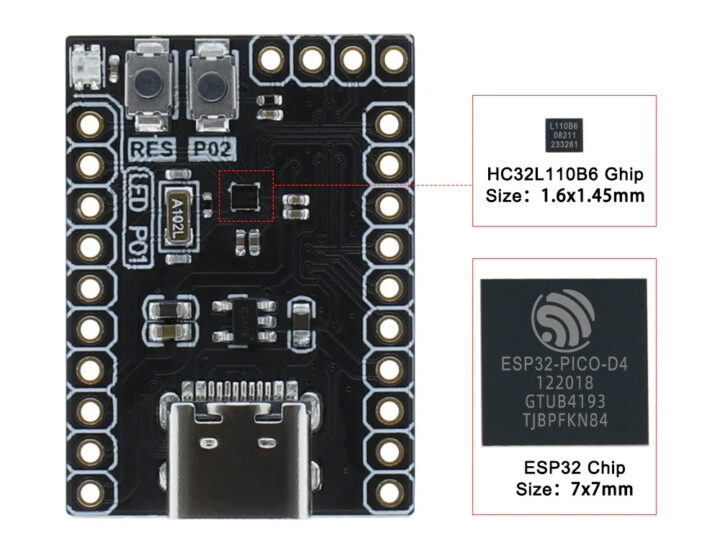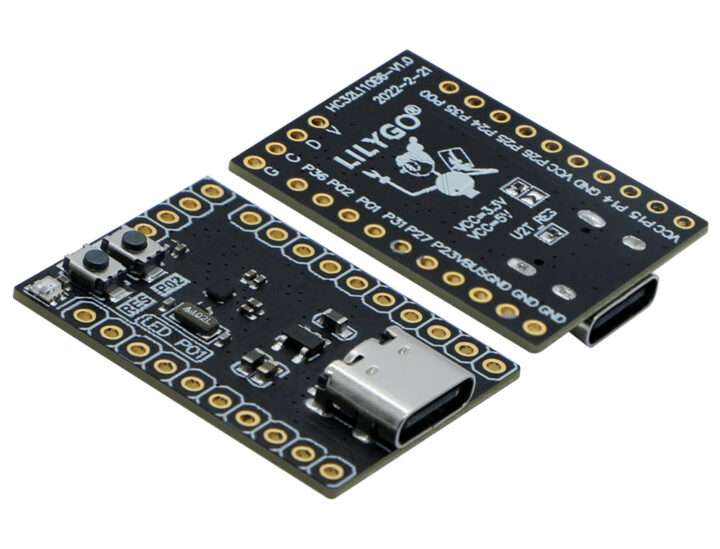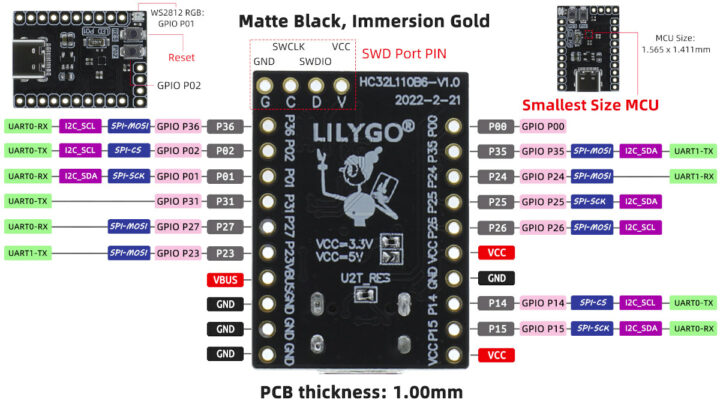HC32L110 Arm Cortex-M0+ MCU is found in a minuscule 1.59 x 1.436 mm CSP16 package that should make it the world’s smallest Arm MCU. LilyGO T-HC32 is one of the first boards with the HC32L110B6 microcontroller, and it is now available for $8.98 on Aliexpress including shipping.
The board offers really basic features with two buttons, a WS2812 RGB LED, and two-row of ten pins each for GPIOs and power signals, plus a 4-pin header for SWD programming. There’s nothing really special about the board or its price, except for the MCU’s size that’s barely discernable from a discrete component, and much smaller than the 7x7mm ESP32-PICO-D4 system-in-package shown in the photo below for comparison.

LilyGO T-HC32 board specifications:
- MCU – HDSC HC32L110B6 Arm Cortex-M0+ @ up to 32 MHz with up to 4KB RAM, up to 32KB flash memory
- Expansion – 2x 10-pin header with GPIO, UART, I2C, SPI, VCC, VBUS, and GND
- Programming – 4-pin SWD header
- Misc – Reset button, user button, WS2812 RGB LED
- Power Supply – 5V via USB Type-C port
- Dimensions – 3 x 2.2 cm
They could have probably made the PCB a little smaller, as some pins are duplicated (VCC and GND), and the board itself is bigger than the nRF52840-based Seeed Studio XIAO BLE Sense board, but at least it could serve as a base to develop ultra-compact solutions based on the HC32L110B6 MCU.
The first time we wrote about the microcontroller there was only documentation in Chinese, but now LilyGO has set up a Github repository with Keil MDK and IAR code samples written in C language, and some basic documentation to get started in English. Sadly all detailed documentation about HC32L110 MCU is still in Chinese only.
 While the T-HC32 board itself is sold for $8.98, you’ll either need a J-Link debugger connected to the SWD interface, or the T-U2T Kit USB to TTL adapter connected to the USB-C port to program the board. The latter is available in a bundle that goes for $14.98 including shipping.
While the T-HC32 board itself is sold for $8.98, you’ll either need a J-Link debugger connected to the SWD interface, or the T-U2T Kit USB to TTL adapter connected to the USB-C port to program the board. The latter is available in a bundle that goes for $14.98 including shipping.

Jean-Luc started CNX Software in 2010 as a part-time endeavor, before quitting his job as a software engineering manager, and starting to write daily news, and reviews full time later in 2011.
Support CNX Software! Donate via cryptocurrencies, become a Patron on Patreon, or purchase goods on Amazon or Aliexpress. We also use affiliate links in articles to earn commissions if you make a purchase after clicking on those links.






That more memory than a Sinclair ZX80 and ZX81 had.
Its as if time and progress goes forward or something. Mind blown.
Not. People did a lot in 1KB ram 8KB ROM.
Also not a Arduino in sight, “The ULA chip, described by the ZX81 manual as the “dogsbody” of the system, has a number of key functions that competing computers share between multiple chips and integrated circuits. These comprise the following:
Creative thinking days.
Heads up: I own+read the ULA book by Chris Smith.
>Not. People did a lot in 1KB ram 8KB ROM.
Yay! I had a spectrum, I also had an Amiga.. I was really glad for having the Amiga because in comparison the spectrum was garbage. And now I have a machine with 64GB of RAM, tons of CPU cores and a RTX 3070TI the Amiga is also garbage in comparison.
Tokenised BASIC was awful and you know it.
>Also not a Arduino in sight,
Not sure what Arduinos have to do with this..
>“The ULA chip, described by the ZX81 manual as the “dogsbody” of the
>Creative thinking days.
There are people out there doing all of the stuff the ULA did in software. This is how far things have progressed.
You really are the tv box + ZX Spectrum version of Jerry.
Disagree, I had ZX81, ZX Spectrum, Atari ST, Atari STE, Pentium P100 I overclocked to 120.
Tokenized basic allowed bigger basic programs in 1K, 16K, 48K etc.
I built many my own PC from parts. DOS, Windows 3.11, 95, 98, XP, 7 and 10. Doing things in software is nothing new, some graphics cards only had features written in the drivers in software.
Ok, Jerry.
OK Jerry
Truly impressive. That’s also an amazing success for the PCB maker to etch copper lanes this thin!
Csp16 for an MCU at 1.4mm squared isn’t really go groundbreaking. There are a lot of 8051’s around. I’m not sure they using arm would be a “claim to fame” either.. sorry for being a negative Nancy, but it’s just more expensive for no parent gain…
It’s discussed here in more detail: https://spritesmods.com/?art=hc32l110
Seems accessing all the pins is the challenge – but you can get at least the essentials without any magic
Oh, I remember seeing very similar photos a few years ago of another uC being soldered with enamelled wire like this. that was impressive. Note, I like to play with minuscule devices, I even assembled two working Breadbee boards, but here it’s one step further 🙂
cant compare with esp32, has 500KB memory and 4MB flash, bluetooth, wifi, and a 160MHz clock, …
Agreed, it should rather be compared with a small Arduino, it’s closer to an ATTiny87.
240MHZ clock
How about a BLE module including the antenna for 4x10x1mm?
https://www.allaboutcircuits.com/news/worlds-smallest-ble-module-emerges-from-toshiba-and-nordic-semiconductor-team-up/
Cortex-M4, 192K flash, 24K RAM
This chip has been used in pills you swallow that send out real-time intestinal readings via the radio.